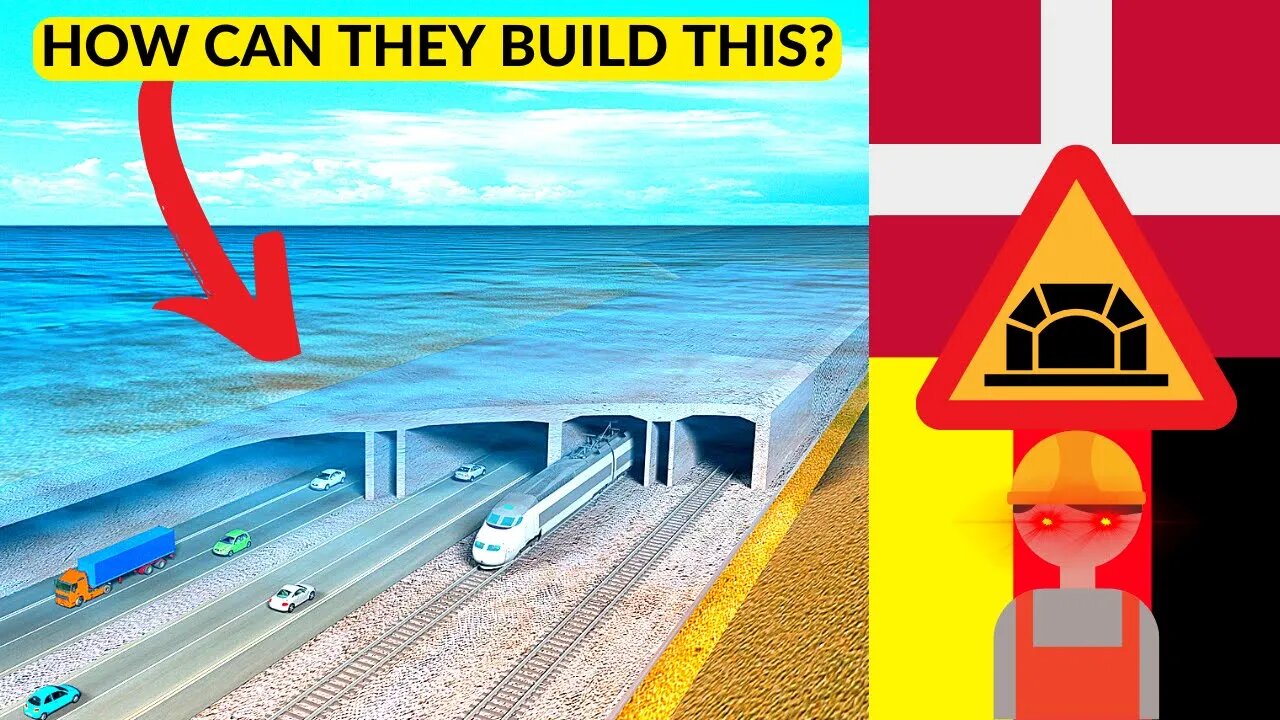Premium Only Content

Europe's Biggest Mega Project That You Haven't Heard Of The Fehmarnbelt Tunnel
👉👉 https://bit.ly/31R197c 👈👈
This is one of Europe’s largest construction sites. The Fehmarnbelt tunnel between Denmark and Germany, near the town of Rødbyhavn on the island of Lolland, will be the largest underwater construction in Europe.
This means that the new link will be the world’s longest immersed tunnel and the fastest route between Scandinavia and Central Europe.
The first step in the construction phase is the large-scale work harbour. It has been specially built to take delivery of the huge quantities of sand, cement, steel and gravel that are required to cast this enormous tunnel.
Behind the harbor they are building a tunnel factory with 6 production halls that will continuously cast the tunnel's 89 concrete sections.
The sections that make up the tunnel will be 217 m long and weigh over 73,000 tonnes. Two double-lane motorway tubes, two railway tubes and a service passage will be included in its construction.
The tunnel sections will be immersed in a 12 meter deep trench on the seabed that is dredged from sea level. In order to clear the seabed for the tunnel it will take 19 million cubic meters of soil, sand and stone which then can be transformed into new beaches and land around the tunnel.
The tunnel factory will be the world’s largest for concrete production. It is expected to provide jobs for thousands of people during construction and manufacturing. The project will also create a number of new jobs in the region, with companies providing raw materials to the site.
The finished tunnel will be assembled from 89 pieces that are cast over a skeleton made out of steel in large moulds. Once the concrete is set, the moulds will then be removed and the tunnel elements will be pushed forwards towards their respective location.
The construction of tunnel sections will be an around-the-clock operation that takes nine weeks to manufacture one section of the tunnel. It's sealed at both ends with bulkheads and the dry dock is flooded when the cement section is ready for transport.
The section is towed out into the deep end of the dock, after which the water level is lowered to sea level. Tugboats will tow the section in position in the Fehmarnbelt, and ballast tanks are filled with water. The section is then lowered on to the sea floor.
For the tunnel to be watertight, it must have all sections installed with millimetre precision. Once they are in place, the water is pumped out. This creates a partial vacuum and ensures a watertight connection.
Finally, once they’ve closed the tunnel off with stone, the stone will act as a protective layer, you're going to see a quick transformation after that as the current will cover the tunnel with sand.
Tunnel buildings are being constructed on Rødbyhavn, Lolland and Puttgarden in Germany to make travel smoother. Once the installation of the tunnel is complete, there will be a smooth transition between land and tunnel.
People will then be able to cross the Fehmarnbelt in seven minutes by train and 10 minutes by car - the world's largest immersed tunnel is estimated to be ready in 2029. Cost of this project is estimated between 7.3 billion euro and 10 billion euro.
-------------------------------------------
Credit:
FemernAS:
https://www.youtube.com/watch?v=5Uop3nun7mM&ab_channel=FemernAS
FemernAS:
https://www.youtube.com/watch?v=LdzqDM2xqAE&ab_channel=FemernAS
FemernAS:
https://www.youtube.com/watch?v=zf7C5DiEVpA&ab_channel=FemernAS
-----------------------------------------------------------------------------------------------------------------------------------------------------------------
Any copyright infringement claims arising from the use of these videos are not intentional. If you are/represent the copyright owner of materials used in this video and have a problem with their use, please send me an email. luxuryprojects11@gmail.com, and we can fix it.
#Construction #Megaproject #Engineering
-
 DVR
DVR
Man in America
6 hours agoFrom Oil Barons to Pill Pushers: The Rockefeller War on Health w/ Jeff Adam
8.01K1 -

Barry Cunningham
3 hours agoBREAKING NEWS: PRESIDENT TRUMP THIS INSANITY MUST END NOW!
53.7K110 -
 LIVE
LIVE
StevieTLIVE
2 hours agoWednesday Warzone Solo HYPE #1 Mullet on Rumble
135 watching -
 5:58
5:58
Mrgunsngear
4 hours ago $0.78 earnedBreaking: The New Republican Party Chairman Is Anti 2nd Amendment
4.46K5 -
 LIVE
LIVE
Geeks + Gamers
3 hours agoGeeks+Gamers Play- MARIO KART WORLD
237 watching -
![(8/27/2025) | SG Sits Down Again w/ Sam Anthony of [Your]News: Progress Reports on Securing "We The People" Citizen Journalism](https://1a-1791.com/video/fww1/d1/s8/6/G/L/3/c/GL3cz.0kob.1.jpg) 29:34
29:34
QNewsPatriot
4 hours ago(8/27/2025) | SG Sits Down Again w/ Sam Anthony of [Your]News: Progress Reports on Securing "We The People" Citizen Journalism
6.93K1 -
 25:12
25:12
Jasmin Laine
8 hours agoDanielle Smith’s EPIC Mic Drop Fact Check Leaves Crowd FROZEN—Poilievre FINISHES the Job
13.6K19 -
 11:33:26
11:33:26
ZWOGs
12 hours ago🔴LIVE IN 1440p! - SoT w/ Pudge & SBL, Ranch Sim w/ Maam & MadHouse, Warzone & More - Come Hang Out!
6.94K -
 LIVE
LIVE
This is the Ray Gaming
1 hour agoI'm Coming Home Coming Home Tell The World... | Rumble Premium Creator
43 watching -
 9:42:31
9:42:31
GrimmHollywood
11 hours ago🔴LIVE • GRIMM HOLLYWOOD • GEARS OF WAR RELOADED CUSTOMS • BRRRAP PACK •
5.61K